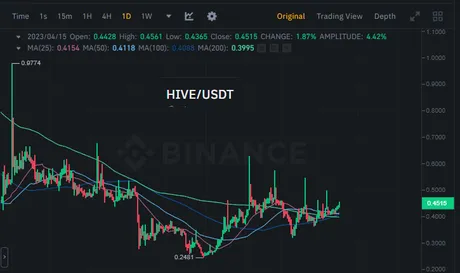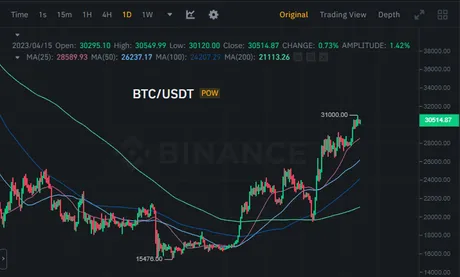
Flat Architecture is weird!
Crypto is a difficult beast to capture or even comprehend. Like water the development flows outward instead of upward. We are so used to legacy corporate architecture and pyramidical systems that our very concept of what crypto is ends up being flawed by our false perceptions and biases.
Crypto is volatile.
The bull market is a flashflood and the bear market is an extreme drought. The sweet spot for stability is few an far between. The only way to truly make it in crypto is so cannister our value during the flood and save it during the drought when everyone else is thirsty.
Easier said than done, I'm afraid. It's like telling people to buy low and sell high. So simple! Sounds easy... and yet that's hardly ever how it works out during the FOMO/FUD cycles we see time and time again every four years.


That awkward phase of stability.
The market looks very good right now. This has been expected. Hive and Bitcoin are neither overbought nor oversold. You could buy here, you could sell here. Feels nice. Doesn't happen often. Savor the moment. It won't last long.
In fact, most tokens are trading well above their moving averages right now. At the same time no one is too keen at selling at these prices. They'd rather wait for the flood, amirite? Of course when the flood comes that's when greed is highest and the most difficult to sell.
Famous last words:
"But what if it keeps going higher?"
"Even if the price goes down from here I'll still be up a ton!"
We've all been the victims of this greed mindset. And we've all been punished for it. Multiple times. Wen will we learn? Maybe never. Everyone likes an exciting coaster.

I wrote this post because I wanted to point out that crypto develops itself so fast that some ideas can become outdated quite quickly. For example: back in 2018 I had an idea in which we could boot up a new reputation system on Hive and leverage that system for peer to peer loans. Every once and a while I think about this idea. A good P2P reputation metric on Hive is sorely needed. Reputation is everything.
However, when considering the idea of P2P loans on Hive, the idea is completely worthless now. Why would you ever loan someone money on Hive if you can just park that money in HBD and earn a 20% yield with zero counterparty risk? Hive will always pay you back, and 20% is a much better return than most are going to be willing to pay back. That's practically loan-shark status at those numbers. Although credit card companies these days will tell you to hold their beer on that note.

We must always have our eyes open when we learn new things about crypto or when core mechanics change. It's a lot to take in, and the shifting sands will open and close doors on a whim. P2P loans on Hive are pretty much out of the question from the economic incentive side of things, but perhaps we can leverage that 20% into other derivative assets like bonds and whatever else. See Taskmaster for details.
It's also worth pointing out that we should always be wary of the know-it-alls in this space who constantly speak out of turn and never admit their mistakes. Their is very little that can be learned from these types of people because it's difficult to know what they get right and what they get wrong, as it's all just assumed to be right, no matter how outlandish the claims are. Blatantly incorrect takes are ignored rather than addressed. It's a terrible way to make progress and learn more. "Fake it till you make it" need not apply here.

The shifting sands are a great thing.
It's very hard to build anything centralized within the crypto ecosystem and have it last long term. We already see centralized exchanges getting cornered by the government quite aggressively. Is this cause for alarm? Quite the contrary, it just means it's yet another centralized path that is cut off from the ecosystem, almost by design. Legitimate paths to victory are decentralized. We know this, and yet we also seem to not know it. Again, it's weird.
Ironically enough, the regulatory agencies like the SEC probably know more about the shifting sands than anyone else. This is why they refuse to provide clarity. They know as soon as they make hardcoded rules that devs will run circles around those protections and entrench themselves into the system under legal protection. The sand turns to concrete when the legacy system allows it to settle.
Regulators are so outdated when it comes to crypto they don't even know what to do, so they do nothing and then just make up the rules as they go, often contradicting themselves. This is expected behavior, although many will rightfully point out the absurdity of it all. Working as intended.

Conclusion
This ecosystem will look completely different in ten years. The winds of change demand it. Ideas that are good today may be completely antiquated a decade down the line, while ideas that are completely untenable today may be the standard due to the rapid shifting sands of development.
The key to surviving this environment is to be agile, modular, and most importantly: actually decentralized. Of course it's hard to know what is and isn't decentralized because marketeers will always default to shilling us the exact same story across the board: a secure decentralized scalable new token awaits! There are no drawbacks! Sure bud. Sure.
Building blocks are the answer. If certain code becomes outdated it doesn't matter if those modules can be repurposed in other projects. Of course that's just the base foundation of open-source development regardless of environmental changes to the digital ecosystem. Staying up to date is difficult, but consistency is key. Speaking of which... it may be time to start writing a post once a day again. Everyone can do their part to some extent.
Posted Using LeoFinance Beta
Return from The Shifting Sands of Crypto to edicted's Web3 Blog
